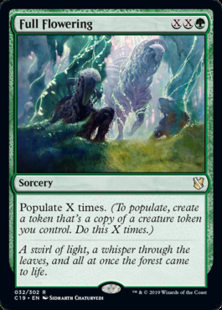 $1.25 @ TCGplayer
$1.25 @ TCGplayer
Populate X times. (To populate, create a token that's a copy of a creature token you control. Do this X times.)
Any enters-the-battlefield abilities of the copied token will trigger when the new token enters the battlefield. Any "as [this creature] enters the battlefield" or "[this creature] enters the battlefield with" abilities of the copied token will also work.
If you choose to copy a creature token that's a copy of another creature, the new creature token will copy the characteristics of whatever the original token is copying.
If you control no creature tokens when you populate, nothing will happen.
Populate doesn't target the creature token you're copying. You choose that creature token as you're taking the populate action. You can choose any creature token you control. If a spell or ability causes you to create a creature token and then instructs you to populate, you may choose to copy the token you just created, or you may choose to copy another creature token you control.
The new creature token copies the characteristics of the original token as stated by the effect that created the original token.
The new token doesn't copy whether the original token is tapped or untapped, whether it has any counters on it or Auras and Equipment attached to it, or any noncopy effects that have changed its power, toughness, color, and so on.
Any abilities that trigger while you're populating won't be put onto the stack until after you've finished populating X times.
Each time you populate, you can pick any creature token you control to copy. You don't have to create X tokens that are all copies of the same creature token.
If X is 0, you don't populate at all.
The tokens enter the battlefield one at a time.